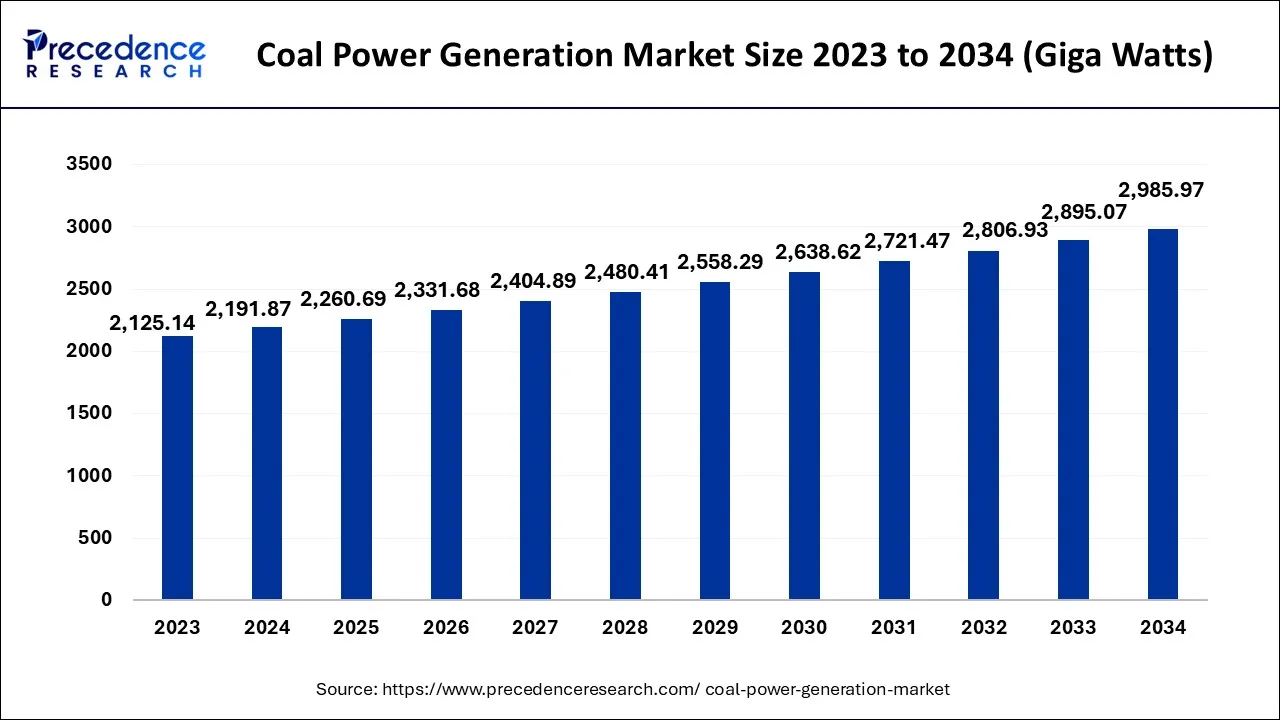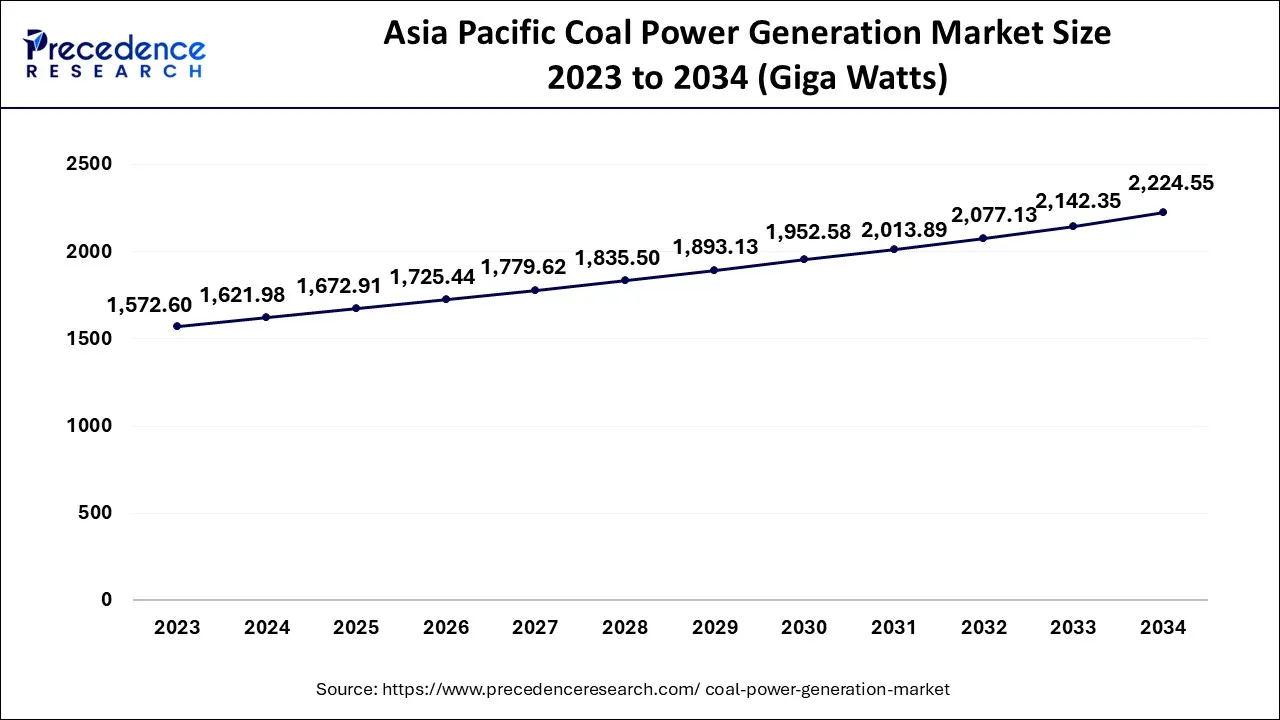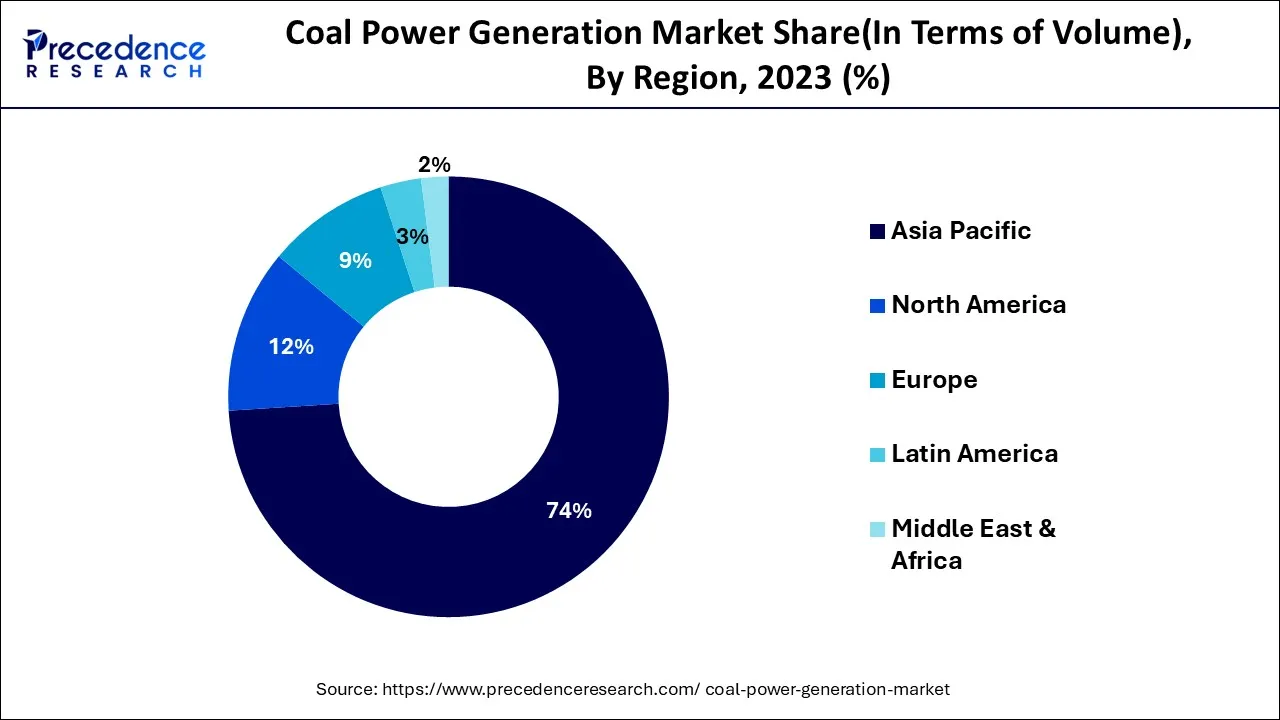February 2025
The global coal power generation market demand is calculated at USD 2,191.87 giga watts in 2024, grew to USD 2,260.69 giga watts in 2025, and is predicted to hit around USD 2,985.97 giga watts by 2034, expanding at a CAGR of 3.14% between 2024 and 2034. The Asia Pacific coal power generation market demand accounted for USD 1,621.98 giga watts in 2024 and is anticipated to grow at the fastest CAGR of 3.21% during the forecast year.
The global coal power generation demand is worth around USD 2,191.87 giga watts in 2024 and is anticipated to reach around USD 2,224.55 giga watts by 2034, growing at a CAGR of 3.14% over the forecast period 2024 to 2034. The presence of low-cost electricity generation technologies in the coal power industry will continue to contribute to the growth of the global coal power generation market.

The Asia Pacific coal power generation demand is exhibited at USD 1,621.98 giga watts in 2024 and is projected to be worth around USD 2,224.55 giga watts by 2034, growing at a CAGR of 3.21% from 2024 to 2034.

Asia Pacific held the dominating volume share of the global coal power generation market in 2023
Asia Pacific region is expected to maintain its dominance throughout the analyzed period. Countries such as Japan, India, China, and Indonesia are major coal consumers as a fuel source for electricity generation due to their large populations and growing economies.
China's coal power generation industry is one of the strongest and most established in the world. China is the world's largest producer and consumer of coal, accounting for around 60% of the country's total primary energy consumption. In China, the coal power generation market is dominated by state-owned enterprises that control the majority of coal production, transportation, and power generation facilities. The large size of China's coal power generation industry has allowed for economies of scale in both coal mining and power generation, resulting in lower costs and higher efficiency.
Several governments and private bodies are shifting towards cost-effective measures to produce electricity; South Korea is intended to be one of such countries that is currently focusing on electricity production while improving the infrastructure of coal power plants.
In October 2022, South Korea’s power utility stated that it is focused on increasing the coal power electricity generation this year to boost the country’s financial health. Under this plan, the Korea Electric Power Corporation (KEPCO) will produce 12.8 terawatt hours with coal instead of using liquified natural gas.

The coal power generation market in the Middle East and Africa is expected to grow significantly during the forecast period. There are multiple opportunities for the coal power generation market in the MEA region, particularly in countries with substantial coal reserves or limited alternative energy sources. There have been some recent developments that suggest that coal power generation may be gaining some traction in the region.
For instance, in 2021, Saudi Arabia announced plans to build a new coal-fired power plant with a capacity of 1.5 gigawatts, which would be the largest coal-fired power plant in the Middle East if completed. The plant is intended to provide a source of baseload power to support the growth of renewable energy sources in the country.
North America is another considerable marketplace for coal power generation. The US government has provided tax incentives to support investment in coal power plant technology. For instance, the federal government has provided tax credits for carbon capture and storage projects, which can help to make these projects more financially viable.
Moreover, the US government has provided loan guarantees to support the construction of new coal-fired power plants. For example, the Department of Energy's Loan Programs Office provided a $1.3 billion loan guarantee to support the construction of the Prairie State Energy Campus, a 1,600-megawatt coal-fired power plant in Illinois.
However, the long-term outlook for the North American coal power generation market is likely to be constrained by a combination of economic and environmental factors, as well as increasing competition from natural gas and renewable energy sources.
Coal power generation is a standard method of producing electricity, as coal is abundant and relatively cheap compared to other sources of energy. The coal power generation market refers to the global market for the production of electricity from coal. It includes the various companies, organizations, and industries involved in mining, transporting, processing, and burning coal to generate electricity.
Increasing government focus on supporting coal power generation, along with effective policies and regulations, is considered to drive the growth of the global coal generation market. Governments around the world are offering subsidies to coal power generation companies; with this, tax incentives by governments help to reduce the cost of producing electricity from coal.
Governments are investing in research and development of new technologies that can improve the efficiency and environmental performance of coal power plants, such as carbon capture and storage technologies. Moreover, governments are significantly promoting the building of coal power plants to support electricity generation by coal power plants in order to boost financial health along with cost-effective electricity production.
The US government has invested in research and development of new technologies that can improve the efficiency and environmental performance of coal power plants. For example, the Department of Energy's Office of Fossil Energy has supported research on carbon capture and storage (CCS) technologies, which can capture carbon dioxide emissions from coal-fired power plants and store them underground.
Along with this, several governmental bodies or departments are also investing in the development of infrastructure, such as ports and railways, that can make it easier and more cost-effective to transport coal to power plants.
Indian railway ports handle significant quantities of imported coal. India is the world's second-largest coal importer, after China, and imports a substantial portion of its coal from countries such as Australia and Indonesia. The ports of Mundra, Krishnapatnam, and Kandla are some of the major ports in India that handle imported coal. The government significantly focuses on developing infrastructure to ease coal transportation in larger quantities with the deployment of advanced technology to induce productivity.
IIT’s Technological Advancement: Supplement for Coal Power Generation
Researchers are consistently seeking for ways to make coal power generation more efficient and cleaner. Several Innovative experiments were conducted on a new kind of nickel alloy that showed promising resistance to oxidation in extreme temperature and pressure conditions. These findings can be instrumental in reducing the environmental impacts of using fossil fuel-based sources like coal for power generation while boosting efficiency levels in the power sector.
| Report Coverage | Details |
| Market Demand in 2024 | 2,191.87 Giga Watts |
| Market Demand by 2034 | 2,985.97 Giga Watts |
| Growth Rate from 2024 to 2034 | CAGR of 3.14% |
| Largest Market | Asia Pacific |
| Base Year | 2023 |
| Forecast Period | 2024 to 2034 |
| Segments Covered | Technology, Application, and Region |
| Regions Covered | North America, Europe, Asia-Pacific, Latin America and Middle East & Africa |
Cost-competitiveness of coal power generation plants
Coal is often a cost-competitive source of electricity generation, particularly in regions where other energy sources, such as renewables, are not yet widely available or cost-effective. Coal power generation is often more affordable than other sources of energy, such as natural gas or renewables, especially in regions where coal is abundant and easily accessible. This can help to ensure that electricity remains affordable and accessible for households and businesses.
Coal power generation can provide reliable and affordable electricity access for regions with limited access to other energy sources. This can be particularly important for developing countries, where access to electricity is still limited. Thus, the cost-competitiveness of coal power generation plants is observed as a critical driver of the growth of the coal power generation market.
Rising demand of electricity
Coal is the prime source of document for electricity generation in several countries around the world. Coal-fired plants produce electricity by burning coal in a boiler to produce steam. In coal-fired power plants, subbituminous coal, bituminous coal, or lignite is burned. Coal power generation is often more affordable than other sources of energy, such as natural gas especially in regions where coal is abundant and easily accessible. Additionally, the cost-competitiveness of coal power generation plants is expected to be the major driving factor for the growth of the coal power generation market. This can help to ensure that electricity remains affordable and accessible for businesses and households. Thus, rising consumption of electricity around the world is likely to propel the growth of the market during the forecast period.
Environmental regulations
Environmental regulations can significantly restrain the growth of the coal power generation market by increasing costs and creating additional regulatory hurdles. Many countries and regions have implemented emissions reduction requirements for coal power plants in an effort to reduce greenhouse gas emissions and combat climate change.
Compliance with these regulations can require significant investments in emissions-reduction technologies, which can increase costs and reduce profitability. Environmental regulations can create additional permitting and approval requirements for coal power plants. These requirements can increase the time and cost of developing new coal power projects, making them less attractive to investors and power generators.
Deployment of carbon capture and storage technology
Carbon capture and storage (CCS) technology creates an opportunity for the coal power generation market to grow by reducing the environmental impact of coal-fired power plants. CCS technology captures carbon dioxide (CO2) emissions from coal-fired power plants and stores them underground, preventing them from entering the atmosphere and contributing to climate change.
With increasing global pressure to reduce greenhouse gas emissions, regulations are being implemented to limit CO2 emissions from power plants. CCS technology can help power plants comply with these regulations, allowing them to continue operating and avoiding potential penalties or shutdowns. With CCS technology, coal-fired power plants can be more competitive with other forms of energy generation that emit fewer greenhouse gases.
The pulverized coal system segment holds the dominating share of the market, In terms of volume. The pulverized coal system is the most commonly used technology in coal power generation plants. The pulverized coal system offers a combination of efficiency, flexibility, reliability, low emissions, and ease of maintenance that makes it a popular choice for coal power generation.
Moreover, the advancements in the pulverized coal system technology are subjected to maintain the segment’s growth during the forecast period. Modern and advanced pulverized coal systems are equipped with advanced pollution control technologies, such as flue gas desulfurization (FGD) and selective catalytic reduction (SCR), which can significantly reduce emissions of sulfur dioxide (SO2), nitrogen oxides (NOx), and particulate matter.
The cyclone furnaces segment is expected to register the fastest growth in the market during the forecast period. The advantages offered by cyclone furnaces over traditional coal-fired power plants are supplementing the segment’s growth. Cyclone furnaces are better able to handle a broader range of coal types, including lower-quality coals that are typically more difficult to burn. This makes them more flexible and adaptable to different coal sources, which can help to reduce costs and increase efficiency.
The residential segment held a significant volume share of the market, and the affordability and reliability of coal power generation for residential consumers have supported the segment’s growth. Coal power generation can be a cost-competitive source of electricity, which can help to keep electricity prices affordable for residential consumers. The enormous demand for household electricity is the primary factor in supplementing the segment’s growth throughout the forecast period.
The commercial and industrial segment is the fastest-growing segment of the coal power generator market; the segment is predicted to hold the largest revenue share during the forecast period. Manufacturing industries and commercial areas require a continuous supply of electricity. The ability of coal power generation plants to produce a large and sufficient amount of electricity constantly has highlighted their industrial use.
Additionally, industries implementing advanced technologies to reduce the CO2 emissions from coal power generation plants are expected to fuel the segment’s growth during the forecast period.
Segments Covered in the Report
By Technology
By Application
By Geography
For inquiries regarding discounts, bulk purchases, or customization requests, please contact us at sales@precedenceresearch.com
No cookie-cutter, only authentic analysis – take the 1st step to become a Precedence Research client
February 2025
September 2024
September 2024
January 2025